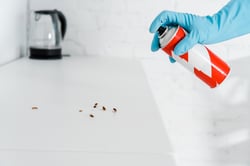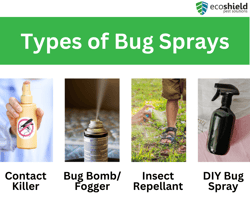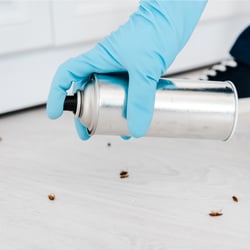There are nearly endless options available to consumers experiencing pest problems. What many don’t realize is that this can be equal parts blessing and curse. While many options may mean the ultimate power of choice as a consumer, it also leaves a lot of responsibility on the shoulders of homeowners. The responsibility of research, cost analysis, and even success/failure falls to homeowners, the weight of which can be crushing (and confusing!) Luckily, we’ve compiled a homeowner’s cheat sheet and guide to pest products: what works, what doesn’t, and what might just be a gamble.

What kind of bug sprays are there?
Before tackling the efficacy of pest products, it’s important to understand what options are available to you and how they work. It should also be noted that some brands and products may only be accessible by professional pest control companies. Professional-grade products may also be stronger or contain higher concentrations of active ingredients than those bought off the shelf. Please keep this in mind when considering your options.

Contact Killers
Contact killer bug sprays are relatively intuitive: simply spray the contact killer on said pest, and they should (theoretically) die. Contact killers are most frequently used for quickly eliminating crawling or flying insects on the spot. For the pests to be successfully killed, they must be directly hit by the spray solution and physically doused by the product. These products are typically geared towards easily spotted insects such as bees and wasps, ants, spiders, cockroaches, and mosquitoes. Contact killers are also commonly marketed toward bed bugs and mite infestations.
Most contact killers use active ingredients like pyrethroids, imiprothrin, cypermethrin, tetramethrin, prallethrin, and permethrin. The key to these ingredients being effective is direct contact. To do this, most contact killers are packaged in aerosol spray cans that can propel the solution a short distance to “hit” your bug targets. Most contact killers are relatively successful in killing on contact; however, they should be regarded as a short-term solution.
Where contact killers fall short is in prevention and long-term treatment. Because contact killers are only effective with direct contact, they do not treat hidden infestations or thoroughly interrupt an insect’s reproductive cycle. When experiencing a pest problem, there is nearly always more than meets the eye - therefore, killing the bugs you see will not eliminate an infestation or permanently rid yourself of insect invaders. It will seem like the bugs just keep coming back, when in reality you never got rid of all of them!
Please be aware that contact killers can be dangerous for kids and pets when used improperly. Please adhere strictly to product instructions and thoroughly research before using contact killers.

Bug Bombs
Bug bombs also referred to as foggers, are aerosol-propelled pesticides that are released all at once in a confined space. There are countless bug bomb products on the market, most of which contain the active ingredient pyrethrin, a common insecticide. Foggers and bombs are typically geared toward cockroaches, bed bugs, and flea infestations. Unfortunately, these products are notoriously ineffective for most homeowners and involve a great deal of prep and aftercare. Unfortunately, many homeowners searching for a cheap fix opt for bug bombs as they can be found at discount or dollar stores for a few bucks. While bug bombs may be cheap in price, homeowners frequently pay in labor, inconvenience, and ineffectiveness.
Most bug bombs require a total evacuation of the space when they are activated. Humans and pets are required to leave the treatment area for a predetermined time frame as indicated by the product’s directions label - this is usually 2-4 hours at minimum. Some products also recommend that you remove food, dishes, plants, and children’s and/or pet toys prior to bombing your space. It is also suggested that you cover your bed and clothes if possible.
In addition to the required prep for bug bombing, there are several recommendations to follow when returning to your space. It is suggested that you wipe down all surfaces with soapy water, open windows, and wash all possible fabric items, such as curtains, couch covers, and bedding. You should also vacuum the entire bombed area and properly dispose of the vacuum’s contents. Don’t forget to thoroughly clean your appliances post-bomb, as well.
In general, we don’t recommend bug bombs and foggers as a first line of defense against pests. Not only are they often ineffective in killing your problem pest, but they also require a great deal of effort on the homeowner’s part both before and after bombing. Bug bombs can also potentially be dangerous if the chemicals are accidentally ingested, especially for children and pets. Please do your research prior to using any bug bomb or fogger product and strictly adhere to the usage instructions to avoid complications and illness.
DEET Insect Repellant
We not only want to keep bugs out of our homes but also off of our bodies! To accomplish this, many of us utilize spray insect repellants when spending time outdoors. Some of these sprays contain an active ingredient called DEET, or diethyltoluamide. DEET is highly effective in repelling a multitude of insects, including mosquitoes, ticks, fleas, and other biting insects. It has long been regarded as the most effective insect repellent due to its ability to interfere with biting insects’ neurons and receptors, making it difficult for them to detect human presence. That said, DEET is somewhat of a controversial ingredient.
The US Environmental Protection Agency has deemed DEET-based products completely safe for individuals of all ages when used correctly; however, there have been some reports of irritation, redness, rashes, and swelling when using DEET. It was also rumored that continued use of DEET might be linked to cancer; however, there is currently no evidence that this correlation exists. Ultimately, most reports of complications with DEET products have been due to incorrect usage of the product or unnecessary concentrations of DEET. Most products contain 50% or less DEET concentration, which is deemed skin-safe by the CDC. The CDC also reported that concentrations over 50% provided no additional protection, meaning a 50% DEET product would be just as effective as a 100% DEET product.
We recommend doing your own research and deciding for yourself whether DEET products are something you’d like to use for you and your family. That said – DEET insect repellents are effective when used correctly and regarded as safe by both the EPA and CDC, along with most reputable institutions.
DIY Bug Sprays
In addition to ready-made products for your home and body, there are DIY recipes for every pest problem you can think of. Needless to say, the efficacy of DIY concoctions is challenging to quantify as each solution contains various ingredients, concentrations, and combinations. Each recipe seems to have lofty claims about household ingredients that will rid you of insects, prevent them from ever entering your home again, and even solving world hunger! Okay, that was a stretch - but these DIY methods really seem to promise you the world. However, the question remains: do they work?
The answer is… maybe!
The fact of the matter is that some DIY solutions have the potential to kill off your problem pest successfully, but without the proper formulation knowledge and application expertise, it’s far more likely that you’ll end up with a weird-smelling concoction that provides disappointing results. There are some natural ingredients that certainly have the ability to prevent or kill insects - neem oil and diatomaceous earth, for example. However, these solutions alone aren’t the answer to every pest problem, and they are useless without the necessary knowledge of how to use them.
In general, we advise against opting for DIY bug sprays for a few reasons. Foremost, it can be dangerous to play chemist and mix random things together with just a blog post or video as your guide. Additionally, many DIY solutions simply do not work or work temporarily at best. Lastly, while DIY may appear like the cheaper option, the costs can add up quickly when experiencing failed attempt after failed attempt.
Got bugs? Call the pros!
Ultimately, the best guidance we can offer is to call a trusted professional when experiencing problem pests. While there are potentially effective bug sprays available off-the-shelf, they are usually a waste of money if you lack the knowledge and expertise to utilize them properly. Even the most potent solutions can fail when in the wrong hands. At EcoShield, we use professional-grade products that are botanically based and safe for both children and pets and are properly applied by our licensed technicians. We have the knowledge and industry-standard best practices to treat your pest problems efficiently. Whether you are dealing with ants, mosquitoes, bed bugs, roaches, stinging insects, mice, or any other household pest, EcoShield has experts ready to help! Call us today or fill out the form on this page to get your free no-obligation quote.